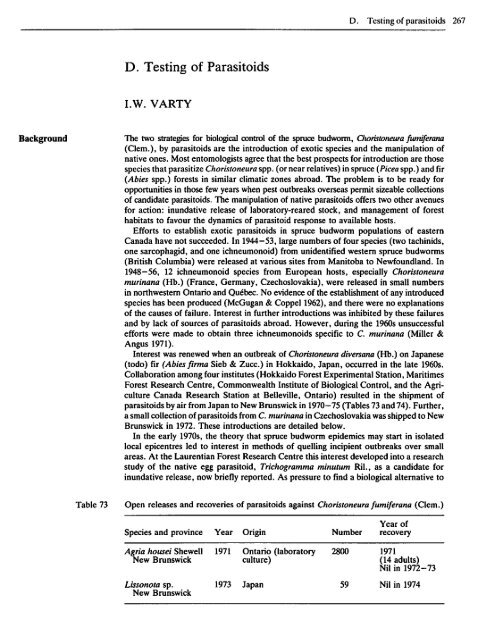pdf, 57.71Mb - Entomological Society of Canada
pdf, 57.71Mb - Entomological Society of Canada
pdf, 57.71Mb - Entomological Society of Canada
Create successful ePaper yourself
Turn your PDF publications into a flip-book with our unique Google optimized e-Paper software.
Background<br />
Table 73<br />
D. Testing <strong>of</strong> Parasitoids<br />
I.W. VARTY<br />
D. Testing <strong>of</strong> parasitoids 267<br />
The two strategies for biological control <strong>of</strong> the spruce budwonn, CJwristoneura fwniferatUl<br />
(Clem.), by parasitoids are the introduction <strong>of</strong> exotic species and the manipulation <strong>of</strong><br />
native ones. Most entomologists agree that the best prospects for introduction are those<br />
species that parasitize Choristoneura spp. (or near relatives) in spruce (Picea spp.) and fir<br />
(Abies spp.) forests in similar climatic zones abroad. The problem is to be ready for<br />
opportunities in those few years when pest outbreaks overseas permit sizeable collections<br />
<strong>of</strong> candidate parasitoids. The manipulation <strong>of</strong> native parasitoids <strong>of</strong>fers two other avenues<br />
for action: inundative release <strong>of</strong> laboratory-reared stock, and management <strong>of</strong> forest<br />
habitats to favour the dynamics <strong>of</strong> parasitoid response to available hosts.<br />
Efforts to establish exotic parasitoids in spruce budworm populations <strong>of</strong> eastern<br />
<strong>Canada</strong> have not succeeded. In 1944-53, large numbers <strong>of</strong> four species (two tachinids,<br />
one sarcophagid, and one ichneumonoid) from unidentified western spruce budworms<br />
(British Columbia) were released at various sites from Manitoba to Newfoundland. In<br />
1948-56, 12 ichneumonoid species from European hosts, especially Choristoneura<br />
murinana (Hb.) (France, Germany, Czechoslovakia), were released in small numbers<br />
in northwestern Ontario and Quebec. No evidence <strong>of</strong> the establishment <strong>of</strong> any introduced<br />
species has been produced (McGugan & CoppeI1962), and there were no explanations<br />
<strong>of</strong> the causes <strong>of</strong> failure. Interest in further introductions was inhibited by these failures<br />
and by lack <strong>of</strong> sources <strong>of</strong> parasitoids abroad. However, during the 1960s unsuccessful<br />
efforts were made to obtain three ichneumonoids specific to C. murinana (Miller &<br />
Angus 1971).<br />
Interest was renewed when an outbreak <strong>of</strong> Choristoneura diversana (Hb.) on Japanese<br />
(todo) fir (Abies firma Sieb & Zucc.) in Hokkaido, Japan, occurred in the late 1960s.<br />
Collaboration among four institutes (Hokkaido Forest Experimental Station, Maritimes<br />
Forest Research Centre, Commonwealth Institute <strong>of</strong> Biological Control, and the Agriculture<br />
<strong>Canada</strong> Research Station at Belleville, Ontario) resulted in the shipment <strong>of</strong><br />
parasitoids by air from Japan to New Brunswick in 1970-75 (Tables 73 and 74). Further,<br />
a small collection <strong>of</strong> parasitoids from C. murinana in Czechoslovakia was shipped to New<br />
Brunswick in 1972. These introductions are detailed below.<br />
In the early 1970s, the theory that spruce budworm epidemics may start in isolated<br />
local epicentres led to interest in methods <strong>of</strong> quelling incipient outbreaks over small<br />
areas. At the Laurentian Forest Research Centre this interest developed into a research<br />
study <strong>of</strong> the native egg parasitoid, Trichogramma minutum Ril., as a candidate for<br />
inundative release, now briefly reported. As pressure to find a biological alternative to<br />
Open releases and recoveries <strong>of</strong> parasitoids against Choristoneura fumiferana (Clem.)<br />
Year <strong>of</strong><br />
Species and province Year Origin Number recovery<br />
Agria housei Shewell 1971 Ontario (laboratory 2800 1971<br />
New Brunswick culture) (14 adults)<br />
Nil in 1972-73<br />
Lissonota sp. 1973 Japan 59 Nil in 1974<br />
New Brunswick
















